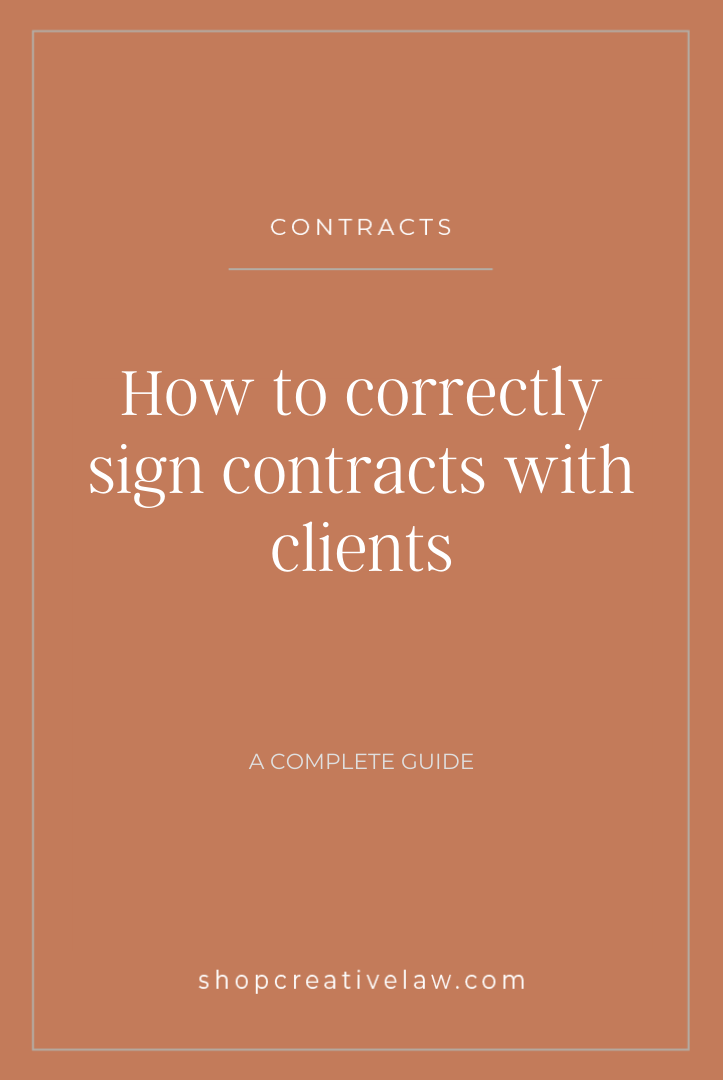Complete Guide: How to correctly sign contracts with clients
Client contracts are one of the primary areas for potential issues and lawsuits in your business, so it’s very important that you get this correct.
In today’s post, we’ll run through the important items you need to know about and exactly HOW to correctly sign contracts with your clients.
The good news? Once you understand these best practices and begin implementing your signing process with this system, you can go forward signing contracts with your clients with ease, knowing you’ve dotted your i’s and crossed your t’s.
How to correctly sign contracts with your clients
Step 1. Get the effective date of the contract right
This sounds simple in theory, but honestly, it’s a bit more complex than you might first think.
The date upon which the contract is effective should be listed in the introductory paragraph of your contract.
This date needs to be the date that the second of the two parties sign the contract.
Step 2. Sign correctly with your name, designation & LLC
Again, sounds simple but in practice, we see many errors with this.
You want to sign in the following structure:
Your name, your designation within the company (eg. owner, manager, etc.), LLC name
So let’s say your name is Mary Johannesson, your title within the company is Founder and your company name is Johannesson International LLC.
You would then sign as follows:
Mary Johannesson, Founder, Johannesson International LLC
And here is an example of how your “Intro” paragraph could read, both if you’re an LLC and your client is a person, as well as if you’re an LLC and your client is also an LLC.
OPTION 1:
IF SIGNING BETWEEN AN INDIVIDUAL AND A BUSINESS (IE, IF YOU HAVE AN LLC, AND YOUR CLIENT IS SIGNING AS AN LLC)
This DJ Services Contract (“Agreement”) is entered into on ___________(day) of ___________(month), __________(year), between John Doe, of 123 John Doe Ave, Dallas, Texas, 54343, referred to as “Client”, and The Creative Law Shop, LLC, an Oklahoma Limited Liability Company, having its principal place of business at 123 Creative Law Shop Lane, Tulsa, OK, 78799, (referred to as “DJ Company Name” or “DJ”). DJ Company Name and Client are collectively known as the “Parties”.
OPTION 2:
IF SIGNING BETWEEN TWO BUSINESSES (IE, IF YOU’RE AN LLC, AND YOUR CLIENT IS AN INDIVIDUAL)
This DJ Services Contract (“Agreement”) is entered into on ___________(day) of ___________(month), __________(year), between John Doe, LLC, a Texas Limited Liability Company, having its principal place of business at of 123 John Doe Ave, Dallas, Texas, 54343, referred to as “Client”, and The Creative Law Shop, LLC, an Oklahoma Limited Liability Company, having its principal place of business at 123 Creative Law Shop Lane, Tulsa, OK, 78799, (referred to as “DJ Company Name” or “DJ). DJ Company Name and Client are collectively known as the “Parties”
Step 3. Get the location of the agreement correct - that is your location!
First, let’s get into why you want the contract location to be your location, and second what to do if your client wants it to be their location.
(This is a HUGE negotiation point in high-level contract deals that lawyers are always arguing about, so don’t take this lightly it really is important.)
We’ll paint a picture to demonstrate why this is so important.
Let’s say your client Sally sues you. The location of the contract will then be the location where the lawsuit will play out. If you live in Mississippi and Sally lives in California, you and your lawyer will need to go to California to fight the lawsuit, meaning major time and financial costs to you to fly over there, stay in a hotel, etc. Not to mention if you run an in-person, brick-and-mortar type business, time away from the business.
What if your client wants the contract location to be their location?
There’s thankfully one fairly simple tool in your belt to make your client question if they really want it to be in their state.
Each state has different contract rules and interprets the law differently and if your contract abides by the laws of your state, and the state was to be changed, you’d need the contract to be reviewed by a lawyer in that state and tweaked.
This of course comes at a high cost and would be incurred by your client.
So if the client doesn’t want to pay for an attorney in their state to tweak your contract, it’s a simple way of ensuring the contract location stays in your location.
contract signing FAQ for creative business owners
with attorney Paige Hulse
Who needs to sign the agreement first? Myself or my client?
You may have heard the advice before that your client should sign the agreement first and you second. If you’re not doing this, take a sigh of relief because this isn’t remotely as relevant today as it was in the past.
The reason this was historically best practice was because you didn’t want to sign the agreement, send it to your client, have them sneakily add something into the agreement, them sign it and suddenly you have agreed to something you hadn’t intended or approved.
These days however with most creative business owners use contract signing softwares, often in their CRM’s, and those softwares only allow clients to fill in specific fields (ie. date, address, name, signature, initials, etc.), so there’s no opportunity for them to edit the contents of the actual contract itself.
So if you’re using a CRM which only allows clients to complete certain fields and not change the contents of the contract, this old best practice doesn’t concern you too much anymore.
Granted, when it comes to clients making errors in signing, it may still be best practice for you to sign second. Read on for more on why!
Can a team member sign a contract on behalf of the business or does it always need to be the founder signing?
Team members may indeed sign contracts with clients, vendors, etc., if they have those permissions spelled out in your Operating Agreement and in their employment agreement.
What’s an Operating Agreement?
It’s the document that governs your LLC and in the eyes of the law helps separate your LLC from yourself, giving you the liability protection you intended when you started the LLC.
Inside your Operating Agreement you may specify points such as who has signing permissions in your business. This Operating Agreement may be updated and changed over time so as team members come and go, you can always adjust who has signing permissions accordingly.
Don’t have an Operating Agreement? You may purchase our attorney-drafted Operating Agreement template in our shop.
If you founded the business yourself, you’ll need the Single Member Operating Agreement, if you founded the business with one or more partners, you’ll need the Multi Member Operating Agreement. (Note: You do not need both, just one!)
What’s an Employment Agreement?
The term ‘employment agreement’ does sometimes mislead a few business owners because it covers not just employees but also contractors too.
So depending on how you hired the person, this would be either the team member’s Independent Contractor Agreement or their Employment Agreement. It’s basically their work contract.
(Yes you may indeed have Independent Contractors sign contracts on behalf of your LLC.)
legal templates mentioned:
What do I do if myself or my client made an error in signing the contract?
In this case send a new contract to replace the old one, and then if you’re using something like Dubsado or Honeybook, simply delete the old agreement from the CRM.
This is another scenario why it’s best practice for you to sign second, because if your client signs the contract first and makes an error, you may spot it and simply not sign the agreement but instead send another one along and give them prompts on how to correctly sign it.
If you don’t sign the agreement as well, it hasn’t been entered into, meaning you don’t need to go through the process of sending a Termination Agreement or replacing the old contract with a new one.
Suggested Reading: How to legally change your client contract when the scope of work, payments, or dates change
Do my & my client’s addresses need to be stated in the contract?
It’s wise to have both of your addresses in the agreement because:
It’s more professional
It’s easier to contact the person in the case of a legal dispute
If your notice provision isn’t correctly completed, having the addresses helps
(A notice provision if you’re wondering if a paragraph in your contract states how someone may get in touch with you, the business owner.)
However, we know many business owners who work from home and don’t want their home address in their contracts.
Good news: There are two ways you can avoid putting your home address in your contract.
The first option is that some states allow you to use a P.O. Box for registering an LLC, and if that’s the case the P.O. Box address may be used in the contract.
The second option is if your state doesn’t allow P.O. Boxes for registering an LLC. Then in this case you’ll need to ensure your contract is worded correctly to use the P.O. Box address in your contract.
All of our client contracts state a ‘principal place of business’ as opposed to a ‘registered address.’
The registered address for forming the LLC would be your actual home address.
However, you could still then get a P.O. Box which is your “principal place of business” and then use that address in contracts, again, assuming your contract is worded correctly and uses the term ‘principal place of business’ not ‘registered address.’
What if my client and I get into a dispute and they argue they didn’t read part of the contract?
To have a valid contract you need to have what’s called a “meeting of the minds” and so if one party is able to prove that they were forced into a contract too fast, or they were told “sign here real quick” and didn’t have the opportunity to read the contract that would be a scenario where a client could argue a contract of adhesion, which is what you as a business owner want to avoid.
For example, let’s say you run a rock climbing gym and you have your clients sign a Liability Release Waiver. If you rush your client to sign it, not giving them the opportunity to read it thoroughly, they could later argue the contract wasn’t valid because they didn’t know what they were signing.
In this scenario, it would be best to take the client to another room outside the hustle & bustle of the reception area, explain the points of the contract, and give them the time and space to read it and sign it at their own pace.
That would go a long way to negating an argument of “I didn’t know what I was signing.”
Does a client need to initial each page or just sign at the bottom?
Just signing at the bottom is all that is technically necessary but there’s also nothing wrong with having your client initial each page. If they sign each page it simply provides more evidence that they did indeed read the entire contract and agree to the entire contract.
It’s not necessary but if you want to be on the safe side, feel free to have your client initial each page.
How do I get a client to understand all the terms of the contract without scaring them off?
Here’s a question we recently were asked by a business owner:
“How to make sure my clients understand the contract without feeling overwhelmed! My onboarding process is already quite long and detailed and I don't want to scare them off. Simplifying things so they understand they must hold up their end of the bargain by providing content, adhering to deadlines, and paying late fees if necessary, is important. But I'm afraid they'll be scared away if I talk about this too much.”
This is an instance where having your client initial certain pages would be wise. The most important aspect you’ll definitely want to have your client initial beside is the payment provision and the cancellation provision.
What you don’t want to do in this situation is force the client to sign quickly while sitting in front of you, as it may then be determined that you didn’t give them enough time to really understand what they were signing.
Typically contracts are sent by email via a CRM system, and in that case, the client may read and sign it at the pace right for them.
Did you find this post helpful? Pin it now.
Find this post helpful? You’ll also love these…
Complete Guide: Creating an internship/externship program in your creative business
Client Contracts 101: The complete guide for creative business owners
Complete guide: How to legally protect your business financially from cancellations
How to legally change your client contract when scope of work, payments or dates change
Why your 50% retainer deposit won't hold up in court and what to do instead








